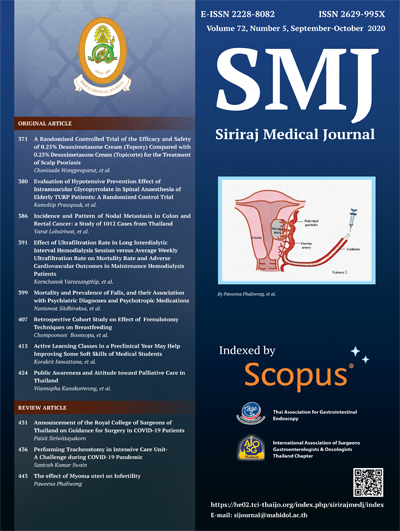Retrospective Cohort Study on Effect of Frenulotomy Techniques on Breastfeeding
DOI:
https://doi.org/10.33192/Smj.2020.55Keywords:
Ankyloglossia, tongue-tie, frenulotomy, breastfeedingAbstract
Objective: The aim of this study was to compare the outcomes between frenulotomy by bedside technique and surgery under general anesthesia to successful breastfeeding in ankyloglossia infants.
Methods: A quantitative research of retrospective cohort study was conducted in Naresuan University Hospital, Thailand between July 2012 and June 2017. We enrolled all infants born and identified the infants diagnosed with ankyloglossia. The severity of ankyloglossia was assessed. The outcome of two types of frenulotomy were compared.
Results: Ankyloglossia was diagnosed in 187 (6.3%) of 2,968 infants born. The main breastfeeding problems in both groups were maternal sore nipples, cracked nipples and poor latch on. The infants in the bedside technique group had more successful rate of exclusive breastfeeding at day 7 when compared with the surgical group (87.3% and 39% respectively, p<0.001). More percent increment of infant’s body weight at day 7 in the bedside technique group than the surgical group (60% and 20.8% respectively, p<0.001). Overall maternal satisfaction in the bedside technique group was notably higher than that in the surgical group (96.4% and 59.7% respectively, p< 0.001). The length of hospital stay was less in the bedside group for 1.22 days. More weight gain was found in the bedside group.
Conclusion: Frenulotomy is the procedure that should be performed in indicated ankyloglossia infants. The bedside technique frenulotomy is preferable than surgery under general anesthesia attributed to a more satisfactory outcome.
References
Breastfeeding and the use of human milk. Pediatrics. 2005;115:496-506.
2. Edmunds J, Miles SC, Fulbrook P. Tongue-tie and breastfeeding: a review of the
literature. Breastfeeding review : professional publication of the Nursing Mothers'
Association of Australia. 2011;19:19-26.
3. Ricke LA, Baker NJ, Madlon-Kay DJ, DeFor TA. Newborn tongue-tie: prevalence and
effect on breast-feeding. The Journal of the American Board of Family Practice.
2005;18:1-7.
4. Hong P, Lago D, Seargeant J, Pellman L, Magit AE, Pransky SM. Defining
ankyloglossia: a case series of anterior and posterior tongue ties. International journal of
pediatric otorhinolaryngology. 2010;74:1003-6.
5. Messner AH, Lalakea ML, Aby J, Macmahon J, Bair E. Ankyloglossia: incidence and
associated feeding difficulties. Archives of otolaryngology--head & neck surgery.
2000;126:36-9.
6. Edmunds JE, Fulbrook P, Miles S. Understanding the experiences of mothers who are
breastfeeding an infant with tongue-tie: a phenomenological study. Journal of human
lactation : official journal of International Lactation Consultant Association.
2013;29:190-5.
7. Kumar M, Kalke E. Tongue-tie, breastfeeding difficulties and the role of Frenotomy.
Acta paediatrica. 2012;101:687-9.
8. Srinivasan A, Dobrich C, Mitnick H, Feldman P. Ankyloglossia in breastfeeding
infants: the effect of frenotomy on maternal nipple pain and latch. Breastfeeding
medicine : the official journal of the Academy of Breastfeeding Medicine. 2006;1:216-
24.
9. Dollberg S, Botzer E, Grunis E, Mimouni FB. Immediate nipple pain relief after
frenotomy in breast-fed infants with ankyloglossia: a randomized, prospective study.
Journal of pediatric surgery. 2006;41:1598-600.
10. Buryk M, Bloom D, Shope T. Efficacy of neonatal release of ankyloglossia: a
randomized trial. Pediatrics. 2011;128:280-8.
11. Geddes DT, Langton DB, Gollow I, Jacobs LA, Hartmann PE, Simmer K.
Frenulotomy for breastfeeding infants with ankyloglossia: effect on milk removal and
sucking mechanism as imaged by ultrasound. Pediatrics. 2008;122:e188-94.
12. Ballard JL, Auer CE, Khoury JC. Ankyloglossia: assessment, incidence, and effect of
frenuloplasty on the breastfeeding dyad. Pediatrics. 2002;110:e63.
13. Soratya S, Mongkol L, Thidaratana W. The comparison of frenulotomy with
conventional frenuloplasty in the management of breastfeeding difficulty. Thai J Surg.
2004; 25:79-83.
14. Muldoon K, Gallagher L, McGuinness D, Smith V. Effect of frenotomy on
breastfeeding variables in infants with ankyloglossia (tongue-tie): a prospective before
and after cohort study. BMC pregnancy and childbirth. 2017;17:373.
15. Puapornpong P, Paritakul P, Suksamarnwong M, Srisuwan S, Ketsuwan S. Nipple
Pain Incidence, the Predisposing Factors, the Recovery Period After Care
Management, and the Exclusive Breastfeeding Outcome. Breastfeeding medicine : the
official journal of the Academy of Breastfeeding Medicine. 2017;12:169-73.
16. O'Shea JE, Foster JP, O'Donnell CP, Breathnach D, Jacobs SE, Todd DA, et al.
Frenotomy for tongue-tie in newborn infants. The Cochrane database of systematic
reviews. 2017;3:CD011065.
17. Hogan M, Westcott C, Griffiths M. Randomized, controlled trial of division of tongue-
tie in infants with feeding problems. Journal of paediatrics and child health.
2005;41:246-50.
18. Schlomer JA, Kemmerer J, Twiss JJ. Evaluating the association of two breastfeeding
assessment tools with breastfeeding problems and breastfeeding satisfaction. Journal
of human lactation : official journal of International Lactation Consultant Association.
1999;15:35-9.
19. Ngerncham S, Laohapensang M, Wongvisutdhi T, Ritjaroen Y, Painpichan N,
Hakularb P, et al. Lingual frenulum and effect on breastfeeding in Thai newborn
infants. Paediatrics and international child health. 2013;33:86-90.
20. Yeh ML. Outpatient division of tongue-tie without anesthesia in infants and children.
World journal of pediatrics : WJP. 2008;4:106-8.
21. Wallace H, Clarke S. Tongue tie division in infants with breast feeding difficulties.
International journal of pediatric otorhinolaryngology. 2006;70:1257-61.
22. Griffiths DM. Do tongue ties affect breastfeeding? Journal of human lactation : official
journal of International Lactation Consultant Association. 2004;20:409-14.
Downloads
Published
How to Cite
Issue
Section
License
Authors who publish with this journal agree to the following conditions:
Copyright Transfer
In submitting a manuscript, the authors acknowledge that the work will become the copyrighted property of Siriraj Medical Journal upon publication.
License
Articles are licensed under a Creative Commons Attribution-NonCommercial-NoDerivatives 4.0 International License (CC BY-NC-ND 4.0). This license allows for the sharing of the work for non-commercial purposes with proper attribution to the authors and the journal. However, it does not permit modifications or the creation of derivative works.
Sharing and Access
Authors are encouraged to share their article on their personal or institutional websites and through other non-commercial platforms. Doing so can increase readership and citations.















